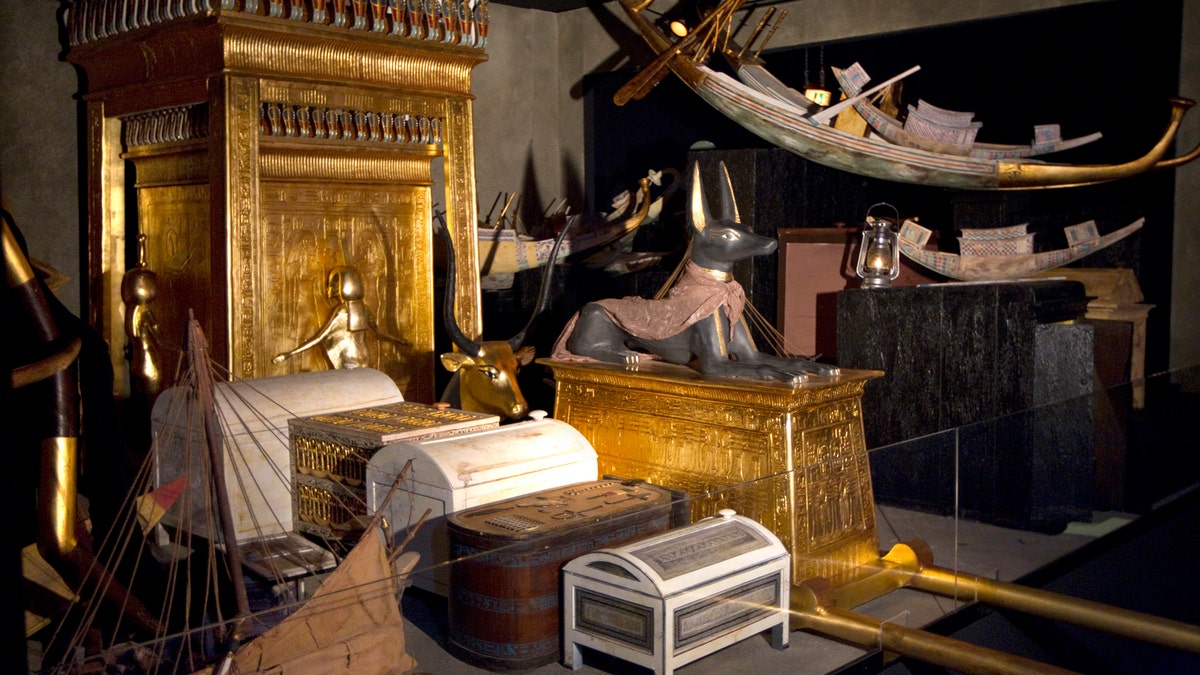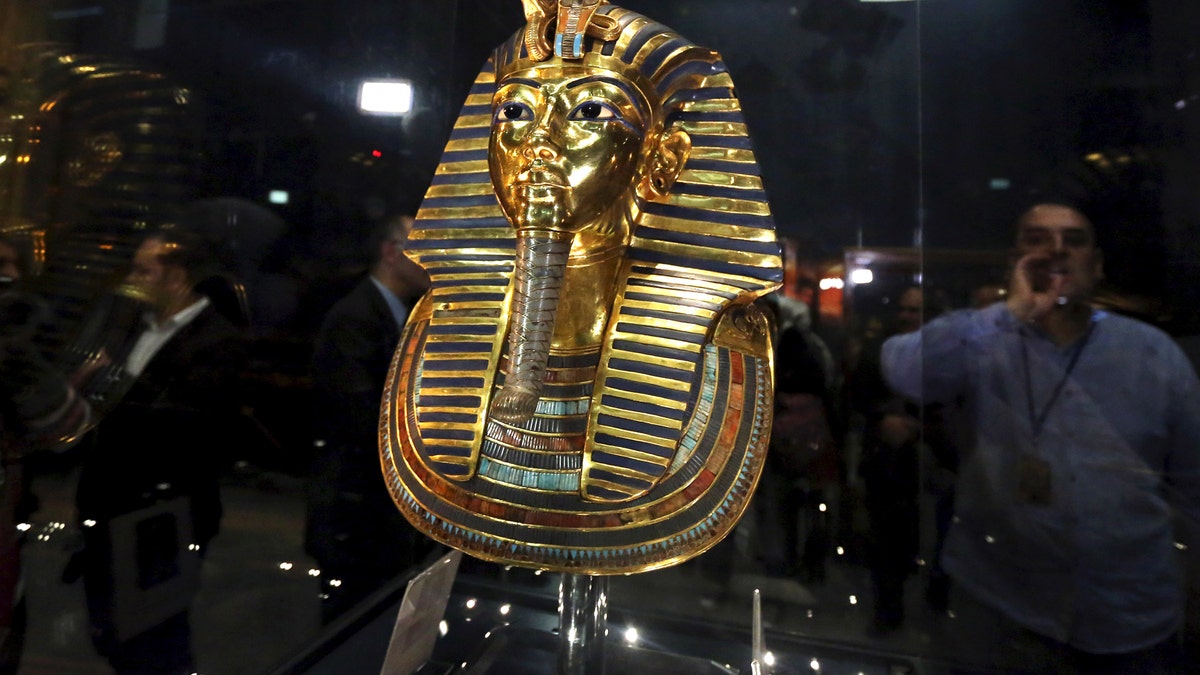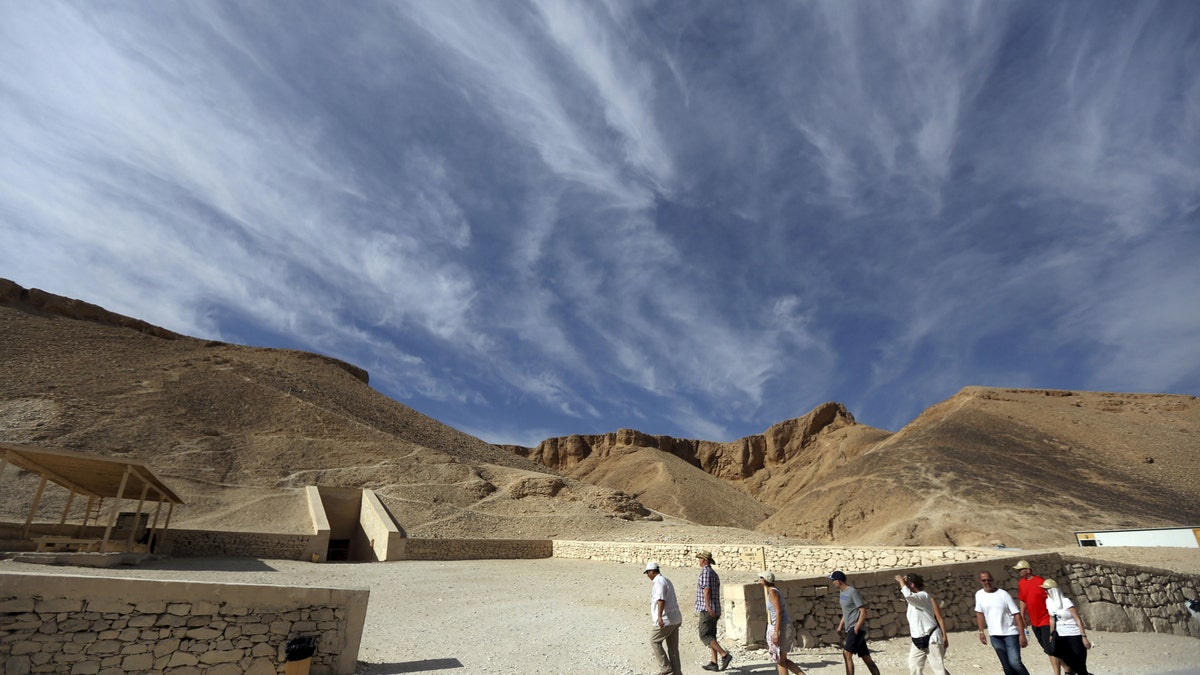King Tut mystery solved: No 'hidden chamber' in famous tomb
Archaeologists have harnessed sophisticated radar scanning technology to disprove the contentious theory that secret rooms are hidden inside King Tutankhamun's burial chamber.
Archaeologists have harnessed sophisticated radar scanning technology to disprove the contentious theory that secret rooms are hidden inside King Tutankhamun's burial chamber.
Egypt's Antiquities Ministry announced the results of the research Sunday, ending years of debate about whether the rooms exist or not.
In 2015, British archaeologist Nicholas Reeves put forward the theory that Tutankhamun’s tomb contains two hidden doorways. The “ghosts” of the hitherto unrecognized doorways could lead to an unexplored western storage chamber and Queen Nefertiti’s final resting place behind the chamber’s northern wall, he said.
IS THIS THE FACE OF TUTANKHAMUN?
The possibility of previously undiscovered chambers in the boy king’s tomb generated massive interest around the world.

FILE - In this April 1, 2016 file photo, radar scanning experts scan a wall in King Tutankhamun's burial chamber in the Valley of the Kings, Luxor, Egypt. Egypt's antiquities ministry said Sunday, May 6, 2018, that new radar scans have provided conclusive evidence that there are no hidden rooms, as was earlier suspected, inside the burial chamber. (AP Photo/Amr Nabil)
Egyptian officials, however, say that no new rooms will be found. Mostafa Waziri, Secretary General of the Supreme Council of Antiquities, said an Italian team conducted extensive studies with ground-penetrating radar that showed the tomb did not contain any hidden, man-made blocking walls as was earlier suspected. Francesco Porcelli, of the Polytechnic University of Turin, presented the findings at an international conference in Cairo.
"Our work shows in a conclusive manner that there are no hidden chambers, no corridors adjacent to Tutankhamun's tomb," Porcelli said. "As you know there was a theory that argued the possible existence of these chambers but unfortunately our work is not supporting this theory."
KING TUT'S DAGGER IS 'OUT OF THIS WORLD'
The pharaoh’s tomb in the Valley of the Kings, which was full of spectacular artifacts, was discovered by British archaeologist Howard Carter in 1922.
In recent years a number of experts have cast doubt on the possibility of hidden rooms in the famous tomb near the city of Luxor. A radar scan organized by National Geographic in 2016, for example, failed to replicate Reeves’ results.
Egypt’s Antiquities ministry noted that the National Geographic scan, and a scan by Japanese scientists, had proved inconclusive. The latest ground-penetrating radar data closes the lid on the tomb having such hidden secrets, it said.
KING TUTANKHAMUN BOMBSHELL? MYSTERIOUS PHARAOH MAY HAVE BEEN A BOY SOLDIER
"It is concluded, with a very high degree of confidence, said Dr. Porcelli, the hypothesis concerning the existence of hidden chambers or corridors adjacent to Tutankhamun's tomb is not supported by the GPR data," it said in its statement.

File photo - View of the Treasury chamber of Pharaoh Tutankhamun's tomb ahead of the opening of a major exhibition on the Ancient Egypt called 'Tutankhamun, his Tomb and his Treasures' in Paris May 11, 2012. The exhibition presented three of Tutankhamun's tomb chambers, which were reconstructed true to the originals and their dimensions, and over 1,000 replicas of the most important objects, fashioned by the best Egyptian craftsmen. (REUTERS/Charles Platiau)
Mystery surrounds the remains of the famous Queen Nefertiti, who was one of the wives of Tutankhamun’s father, the Pharaoh Akhenaten.
However, some archaeologists believe the mummy of Nefertiti, fabled for her beauty, has already been found in a different tomb.
MYSTERY OF 'SCREAMING EGYPTIAN MUMMY' WHICH HAS BAFFLED ARCHAEOLOGISTS FOR YEARS FINALLY RESOLVED
King Tutankhamun continues to fascinate historians. Stunning new research, for example, claims Tutankhamun may have been a boy soldier, challenging the theory that the King was a weak and sickly youth before his mysterious death at around 18 years of age.

File photo - The golden mask of King Tutankhamun is displayed inside a glass cabinet at the Egyptian Museum in Cairo, Egypt, December 16, 2015. (REUTERS/Mohamed Abd El Ghany)
In 2014, a BBC documentary used state-of-the-art technology to perform a ‘virtual autopsy’ on King Tutankhamun’s 3,000-year old remains. By using 2,000 Computerized Tomography (CT) scans of the pharaoh’s mummified body, scientists created a full size computer-generated image of Tutankhamun. The virtual autopsy indicated that the boy king suffered from a genetic bone wasting disease and a club foot, making him unable to walk unaided.
Another theory suggests that Tutankhamun died in a chariot crash.
DESERT DISCOVERY: LOST TEMPLE OF RAMSES II UNCOVERED BY ARCHAEOLOGISTS
In 2012, scientists confirmed that a dagger found among the treasures in King Tut’s tomb was made with iron from a meteorite.

File photo - Tourists visit the Valley of the Kings in Luxor, Egypt, Nov. 28, 2015. (REUTERS/Mohamed Abd El Ghany)
The findings of the latest radar survey were presented during the fourth International Tutankhamun Conference in Cairo.
The Egyptian Antiquities Ministry has been gradually moving King Tut's belongings to the Grand Egyptian Museum, a new museum outside Cairo near the Giza Pyramids to undergo restoration before they are put on display.
During the conference, Egypt’s Antiquities Minister Khaled al-Anani said that the first phase of the new museum, including King Tut's halls, will be completed by the end of this year but the date for the museum's "soft opening" has yet to be decided. The museum currently hosts more than 43,200 artifacts of which over 4,500 belong to King Tut alone, and its grand opening is planned for 2022.
The Associated Press contributed to this article.
Follow James Rogers on Twitter @jamesjrogers





















